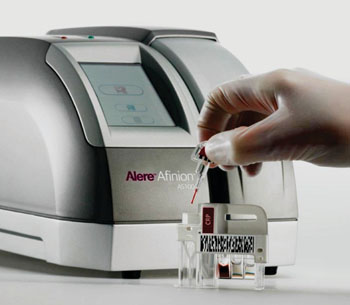Rapid Blood Test Can Rule Out Serious Childhood Infections
By LabMedica International staff writers
Posted on 19 Oct 2016
The care for acutely ill children has traditionally been a primary care responsibility, but increasing numbers are being seen in secondary care, but a simple decision rule and a finger prick to test blood, general practitioners can now detect serious infections in children very quickly.Posted on 19 Oct 2016
The introduction of better diagnostic tests might strengthen the primary care management of acutely ill children and inflammatory markers such as C-reactive protein (CRP) and procalcitonin can assist in diagnosing serious infections in hospital settings.

Image: The Afinion C-reactive protein (CRP) test cartridge and Afinion AS100 analyzer (Photo courtesy of Alere).
Scientists at the University of Leuven (Belgium) and their colleagues assessed a whether performing point-of-care CRP testing should be done in all children presenting with acute infection in primary care or only in those deemed at high-risk of serious illness after initial clinical assessment. They also investigated how CRP results should be interpreted; specifically, whether a low CRP level can rule out infection and the consequent need for hospital referral.
A cluster randomized controlled trial was carried out involving acutely ill children presenting to 133 general practitioners (GPs) at 78 GP practices in Belgium. Practices were randomized to undertake point-of-care CRP testing in all children (1,730 episodes) or restricted to children identified as at clinical risk (1,417 episodes). In the “CRP only if at clinical risk” group, CRP testing was dependent on the presence of at least one of the following clinical features: breathlessness, body temperature of at least 40 °C, diarrhea in children 12–30 months of age, and clinician concern. The Afinion CRP Test Cartridge (Alere, Waltham, MA, USA) was used, which has a measuring range for CRP of 5–200 mg/L and requires 1.5 μL of blood obtained by finger prick, providing a result within four minutes. They trained all physicians to perform the CRP test.
The investigators found that t restricting CRP testing to children at clinical risk (because of breathlessness, temperature equal to or greater than 40 °C, diarrhea and age 12 to 30 months, or clinician concern) substantially reduced the number of children tested to 285/1,417. The team reported that restricting CRP testing to those identified as at clinical risk increased the median CRP level of the children tested from 7 mg/L to 11 mg/L. Time from onset of fever did not influence the median point-of-care CRP level.
Jan Y. Verbakel, MD, PhD, a general practitioner and lead author of the study said, “As a result, serious infections tend to stay off the general practitioner's radar for too long. We asked ourselves how rapid diagnostic tests might help solve this problem. Thanks to the combination of a clinical examination of the patient, possibly followed by a point-of- care CRP test, general practitioners can detect serious infections more quickly and more objectively. And for children who are less seriously ill, the procedure prevents unnecessary hospital referrals and anxiety. The point-of-care CRP test is a valuable tool for general practitioners, but it has to be used responsibly.” The study was published on October 6, 2016, in the journal BMC Medicine.
Related Links:
University of Leuven
Alere




 assay.jpg)








